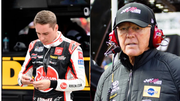
via Imago
DOVER INTERNATIONAL SPEEDWAY, UNITED STATES OF AMERICA – MAY 04: #20: Christopher Bell, Joe Gibbs Racing, Toyota Camry Rheem/Comcast Salute to Service Jason Ratcliff during the Dover at Dover International Speedway on May 04, 2018 in Dover International Speedway, United States of America. (Photo by Matthew T. Thacker / NKP / LAT Images)

via Imago
DOVER INTERNATIONAL SPEEDWAY, UNITED STATES OF AMERICA – MAY 04: #20: Christopher Bell, Joe Gibbs Racing, Toyota Camry Rheem/Comcast Salute to Service Jason Ratcliff during the Dover at Dover International Speedway on May 04, 2018 in Dover International Speedway, United States of America. (Photo by Matthew T. Thacker / NKP / LAT Images)
Strategy means everything in NASCAR. The difference between a win and a loss is, more often than not, just a pit stop. It’s kind of ironic that in a sport where the cars move over 200 mph, the race is decided on how long the cars have been stationary. Cutting the speed down to 0 is never recommended, let alone the pit stop time, so it is advisable to have minimum stops.
While most motorsports have pit stops to help the vehicle sustain itself through the race, the way each one of them is carried out differs. While F1 pit stops are wrapped up in under 3 seconds, NASCAR is a different game. To explain the rules of the pitstop, Joe Gibbs Racing gave a comprehensive breakdown of how they work in their latest Instagram reel.
ADVERTISEMENT
Article continues below this ad
Different types of pitstops in NASCAR explained by Joe Gibbs & Co.
Earlier this year, NASCAR’s annual visit to Circuit of the Americas in Austin, Texas, brought a fuel strategy showdown like no other. The fuelers were the real MVPs, as many pit stops hinged on their ability to get a car fully fueled before it could peel out of the pit box. With a staggering 116 pit stops where crews swapped out all four tires, only 35 managed to break the 10-second barrier.
As Joe Gibbs’ time was 6th best in COTA NASCAR, the officials took the initiative to explain the different types of pitstops with a video to make it easy for new fans to get with the rules. The video was dropped as an Instagram reel, which is great for people to pick up information on the subject within just 25 seconds. So here is how Joe Gibbs Racing explains NASCAR pitstops.
“What’s the difference between a two-tire, four-tire, and fuel-only pit stop?” That’s pretty much how the video starts. Now that the question was asked, here is their answer to how JGR manages their pitstops. It all comes down to strategy and what the car needs; it’s as simple as that.
- Two-Tire Pit Stop: Teams opt for this to gain track position, usually changing only the right-side tires, which wear out faster.
- Fuel-Only Pit Stop: This is common towards the end of a stage or race, ensuring the car has enough gas to finish.
- Four-Tire Pit Stop: Teams replace all four tires and refuel the car, a strategy used 2-3 times during a race and crucial for success.
View this post on Instagram
What’s your perspective on:
Can Joe Gibbs Racing's new pitstop strategy give them the edge to dominate NASCAR this season?
Have an interesting take?
The time lost in the pitstops is crucial during the race, which is why it’s always better to go for a strategy that reduces the number of pitstops needed. Towards the end of the video, Joe Gibbs Racing flexed their pitstop timing, announcing that they often get the 4-tire and fuel pitstop done within around 9 seconds.
ADVERTISEMENT
Article continues below this ad
Trending
The COTA pit stops
It wasn’t that the crews were slacking; rather, cars were being held after the tire changes to ensure they were packed with enough fuel to go the distance. The typical race strategy called for three pit stops, but the No. 20 Joe Gibbs Racing team decided to shake things up with a bold two-stop strategy. This meant a longer pit stop, as the Toyota Camry needed two cans of fuel to top off for an extended run.
The pit crews were working their tails off, and the tension was palpable. Every second counted, and the fuelers had to be spot-on. The No. 20 team’s gamble to go against the grain with fewer stops showcased the high-stakes chess game that is NASCAR pit strategy. It’s these kinds of decisions that can make or break a race, proving once again that in NASCAR, it’s not just about the speed on the track, but the precision and strategy in the pits.
ADVERTISEMENT
Article continues below this ad
This only shows how it’s not only the driver who is under pressure, as a good pit crew comes in clutch during difficult races. But there are more technical rules and terms in NASCAR that often leave fans confused. One of them is the new format that was introduced in 2017. So let’s see how the new format governs the tracks today.
The fastest individual pit stops of the season look fairly similar, with crews from Joe Gibbs Racing and Hendrick Motorsports taking up much of the chart. After COTA weekend, the No. 11 crew of Denny Hamlin was once again at the top with a season-record time of just 8.59 seconds for a four-tire change. Every single stop in the top 10 is below nine seconds, showing just how competitive the NASCAR Cup Series field has become both on-track and on pit road.
ADVERTISEMENT
ADVERTISEMENT
ADVERTISEMENT
ADVERTISEMENT







Can Joe Gibbs Racing's new pitstop strategy give them the edge to dominate NASCAR this season?